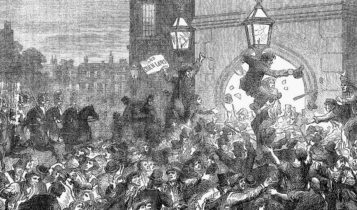The summer of 1816 has an unusual claim to fame. It is known as The Year Without a Summer. How did it come by this unusual moniker? The answer lies in the events of the previous year. In 1815 Mount Tambora on the island of Sumbawa in the Dutch East Indies, modern day Indonesia, erupted. It was the largest volcanic eruption for 1,300 years. It had a significant effect on the global climate causing severe weather abnormalities. It resulted in a decrease in global temperatures by 0.4 – 0.7 OC. This may not sound like much but the impact of this was significant.
Earth had been in a period of global cooling from the fourteenth century. This “little ice age” was aggravated by the 1815 eruption. New England (US), Atlantic Canada and large swathes of Western Europe and China experienced agricultural disaster. The spring and summer of 1816 was marked by consistent dry fog across the east coast of America that reddened and dimmed in the sunlight. One result of this was that sunspots were visible to the naked eye. Even wind and rain didn’t dispel the fog. For many this gave it an unusual, perhaps even supernatural quality. This fog has since been characterised by scientists as a “stratospheric sulfate aerosol veil”.
It is important to note that the understanding of the eruption has come in recent years with volcanologist and scientists being able to better understand the events of 1816. In line with this, historians have been able to take this new information and apply it to their understanding of the time. For example, riots occurred across France and Great Britain in 1816. The causes are now known to be linked to the eruption. Arson, looting of grain warehouses and political unrest was accompanied by a revival in religious demonstrations. The numbers recorded as attending church and chapel services increased during this period.

In a previous article I looked at the ideas and climate that contributed to the writing of Mary Shelley’s Frankenstein. She began the novel at Lord Byron’s villa on Lake Geneva. Switzerland was particularly badly hit by the climatic changes. One example is that an ice dam formed below the tongue of the Gietro Glacier (high in the Val de Bagnes) in 1816 and 1817. Eventually the dam collapsed under its own weight in the June of 1818, contributing to flooding in the Swiss capital. Further to this crop failures resulted in famine conditions with the government declaring a national emergency. This is considered to be continental Europe’s last ever famine which was accompanied by rising mortality rates. The flooding was worsened by the unseasonably large storms and rainfall that flooded many major European major rivers. After this came frost in August. The melt resulted in further flooding.
In May the frost was so intense that it killed off crops in Massachusetts, New Hampshire, Vermont and upstate New York. Higher elevations suffered the most. Snow was recorded as falling on June 6th 1816 in Albany, New York and Maine. Following on from this in New York in May temperatures were recorded as dipping below freezing most days. On June 9th the ground froze solid and crops failed.
Closer to home the cost of bread in Britain almost doubled in the same space of time. Cool temperatures and heavy rains had resulted in failed harvests. Bread shortages led to riots breaking out in East Anglia in May 1816. In the town of Ely labourers armed themselves before marching on the town and taking the magistrate hostage. They were holding banners bearing the slogan “Bread or Blood” and fought a pitched battle with the militia. The bread shortages also fuelled mass demonstrations in many of the larger cities. The army were often used to combat the civil unrest as feelings of discontent and frustration grew. Prison numbers increased as rioters were jailed, as did the number of those executed or sentenced to transportation. However, Britain was better able to deal with the food shortages than much else of Europe due to established trading links with Western America.
[perfectpullquote align=”right” cite=”” link=”” color=”#2FB3C9″ class=”” size=”19″]In May the frost was so intense that it killed off crops in Massachusetts, New Hampshire, Vermont and upstate New York. Higher elevations suffered the most. Snow was recorded as falling on June 6th 1816 in Albany, New York and Maine.[/perfectpullquote]
North and South West Ireland also saw the failure of wheat, oat and potato harvests. Ireland seems to have been particularly vulnerable. There was a major typhus epidemic from 1816 – 1819 in which an estimated 100,000 people died. In Ireland a recorded 80,000 people were infected. 44,000 died [1]. Figures vary however it is clear that Ireland was hard hit by the epidemic. High levels of unemployment had followed the demobilisation of the British army following the end of the Napoleonic wars. Many were living in abject poverty with little food available.
So how could one volcanic eruption have such a big impact? The eruption of Mount Tambora occurred between 5th and 15th April 1816. It ranked VEI 7 on the Volcanic Explosivity Index. To put this into perspective this eruption was over 1,000 times greater than the 2010 Iceland eruption that caused mass travel chaos. The sound of the eruption was reportedly heard up to 2,000 miles away. Millions of tonnes of sulphur dioxide, ash and pumice were ejected into the atmosphere. An ‘umbrella’ of ash spread over a million square kilometres. Billions of tonnes of dust, gas, rock and ash scoured the surrounding area before hitting the sea at such velocity that it triggered a tsunami. A 2 metre high wave hit the East Cost of Java. This was 500km away. The wave had enough power to travel for over two hours before it reached land. Further to this, hurricanes of debris incinerated the area 20 km radius of the volcano. The eruption was incredibly devastating. Clive Oppenheimer, a volcanologist with Cambridge University has placed the number of deaths between 60,000 and 120,000. These figures vary however what is sure is that this caused the largest death toll as a direct result of a volcanic eruption in recorded history. The loss of life continued in the months after the eruption as disease, famine and pestilence ravaged the area.

The effects were recorded by Sir Thomas Stamford Raffles. A British Statesmen he was best known for his involvement in the conquest of Java over the Dutch and French military forces during the Napoleonic Wars and his role in the founding of Singapore. Usefully he also wrote a memoir which included details of the eruption and its aftermath. [2] According to the British Library, Raffles collected first-hand accounts of the eruption from people living about 400 km from the volcano. He noted that the eruption lasted for over a week with the major explosions occurring on the 5th and the 10th of April. He is also a vital source of information for the effect the eruption had on the local area.
The eruption of Mount Tambora was intensified as the 1816 eruption came on the heels of several other volcanic explosions. Examples of this include eruptions in 1809, in the Pacific Ocean, and an 1812 eruption on the Caribbean island of Saint Vincent. Added to this was the impact of an 1813 eruption in Japan and another 1814 eruption in the Philippines. These eruptions contributed to a substantial build-up of atmospheric dust. This resulted in less sunlight passing through the stratosphere leading to a drop in temperature. The decade of 1810 to 1820 was the coldest in 200 years.
In the United States crop failures had a different impact. Migration increased as individuals and families moved away from the food shortages in New England on the east coast and began to settle in the more hospitable areas of West and Central New York and the American Midwest. This contributed to the settling of the “American Heartland”. Grain prices had collapsed which contributed to the first major American economic depression. One side effect of this was that the cost of oats rose from 12c a bushel in 1815 to 92c a bushel in 1816. The climatic changes continued into 1817 with temperatures in Central and Northern New York recorded as being as low as -30OF in the winter and snow falling in the August. This came after months of hard frosts that froze the ground, destroying further crops.
In a letter dated 8th September 1816 Thomas Jefferson had this to say. [3]
“We have had the most extraordinary year of drought and cold ever known in the history of America. In June, instead of 3 ¾ inches, our average of rain for that month, we only had ? of an inch; in August, instead of 9 1/6 inches, our average, we had only 8/10 of an inch; and still it continues. The summer, too, has been as cold as a moderate winter. In every State north of this there has been frost in every month of the year; in this State we had none in June and July, but those of August killed much corn over the mountains. The crop of corn through the Atlantic States will probably be less than one-third of an ordinary one, that of tobacco still less, and of mean quality. The crop of wheat was middling in quantity, but excellent in quality. But every species of bread grain taken together will not be sufficient for the subsistence of the inhabitants, and the exportation of flour, already begun by the indebted and the improvident, to whatsoever degree it may be carried, will be exactly so much taken from the mouths of our own citizens. My anxieties on this subject are the greater, because I remember the deaths which the drought of 1755 in Virginia produced from the want of food.”
Joseph Smith’s family was one of the many to migrate. They lived in Norwich, Vermont, from 1814 to 1816. Due to the bad harvests they were one of the families that moved west, in their case to Palmyra in New York. The population of Vermont decreased from 15,000 to 10,000 at this time. In 1816 Joseph Smith Jr was 10 years old. He would later become known as “The Prophet”. The family moved to an area known for its intense religious revivalism. “The Burned Over District” [4], in west and central New York became known for the frequent religious revivals that took place there. They were so frequent and potent that this era became known as hosting the “Second Great Awakening”. This Protestant religious revivalism resulted in membership of Baptist and Methodist congregations rising rapidly. Rejecting rationalism, it placed emphasise on emotion and the supernatural.

This was fertile ground for a new religious occurrence to take place. Shortly after their arrival Joseph Smith Jr began to experience a series of visions. These were intense spiritual events that had a profound effect on him. In one of his visions an angel directed him to a buried book of golden plates inscribed with a Judeo – Christian history of an ancient American civilisation. Over time he wrote down all he learned and in 1830 published an English translation of the plates. This book was called The Book of Mormon and led to the founding of the Church of Latter Day Saints. It is fascinating the think how a volcanic eruption in Indonesia could influence religious beliefs in America.
[1] In Our Time podcast. 1816 The Year Without a Summer
[2] Raffles, S. 1830: Memoir of the life and public services of Sir Thomas Stamford Raffles, F.R.S. &c., particularly in the government of Java 1811–1816, and of Bencoolen and its dependencies 1817–1824: with details of the commerce and resources of the eastern archipelago, and selections from his correspondence. London. John Murray, cited by Oppenheimer (2003).
[3] Source
[4] So called because it had been burned over by so many different religions.
